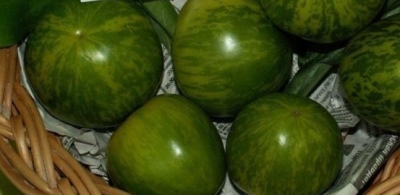
- Authors: Ugarova S.V., Dederko V.N., Postnikova O.V.
- Year of approval: 2008
- Category: grade
- Growth type: indeterminate
- Appointment: fresh consumption, for whole fruit preservation
- Ripening period: late ripening
- Growing conditions: for open ground, for closed ground
- Marketability: high
- Bush size: tall
- Bush height, cm: 120-190
For tomatoes, the combination of unusual color and ease of care is quite rare. This is the sort of Siberian malachite. Rounded emerald fruits, which outwardly look like variegated quail eggs, wonderful taste, coupled with the beneficial properties of fruits and simple agricultural technology, made the culture one of the favorites among gardeners.
Breeding history
An unusual variety was bred in Novosibirsk by experienced breeders Ugarova S.V., Dederko V.N. and Postnikova O.V. 2008 year.
Description of the variety
Siberian malachite is a tall plant with an indeterminate type of growth. The culture is distinguished by the presence of strong trunks, the height of which varies from 120 to 190 centimeters. This will depend on where it is grown. Bushes growing in greenhouse conditions can be very tall, up to two meters. With soil cultivation, Siberian malachite will be much lower. Each bunch contains 5-7 fruits, they are all even, smooth, very decorative look.
The main qualities of the fruit
The main characteristic feature of Siberian malachite is the original color of the berries. In an unripe form, the tomato is green, has stripes, but after the onset of full maturity, its green color remains, but yellow is added to it as picturesque veins or golden stripes.
The fruits of the variety in question are distinguished by a round shape, moderate size, on average, the mass of a tomato is 120-150 grams. Inside, the fruits have seed nests, there may be 4 or more of them.
Taste characteristics
Siberian malachite tomatoes in their high taste indicators in many respects surpass some red tomatoes. They are sweet, fruity, juicy, and contain a lot of carotene, so they do not cause allergies. They are often used in baby and dietetic diets. The veined emerald pulp looks very interesting when cut.
Perfect for both fresh consumption and whole canning. The fruits are dense, therefore they do not crack, they look great inside the jar. In addition to spectacular slicing and summer salads, they are used in the preparation of hot dishes, juices, pastes, and allsorts.
This is one of the healthiest tomatoes and can be consumed even by those on a diet.
Ripening and fruiting
Siberian malachite is ranked among both mid-ripening and late-ripening cultures, but nevertheless it is closer to the late-ripening group.
Cultivars that ripen late have their own benefits. For example, if different varieties are grown on the site, the early ripening ones have finished bearing fruit, and the later ones have just begun to ripen. As a result, it turns out that there will be fresh tasty tomatoes on the table almost all summer. And also late-ripening tomatoes, as a rule, are stored longer and are well transported.
Yield
Siberian malachite has a high yield - from 10.6 to 12 kg per 1 sq. meter of beds.
The timing of planting seedlings and planting in the ground
Sowing seeds of Siberian malachite for seedlings is done in advance, that is, 50-60 days before transferring directly to the ground.For successful germination of seed, it is necessary to maintain the optimum temperature at 23-25 ° C.

Growing tomato seedlings is an extremely important process, because it largely depends on whether the gardener will be able to harvest at all. All aspects must be taken into account, from seedbed preparation to planting in the ground.
Landing scheme
Since the plants are tall and spreading, 3-4 plants are planted on one "square". In this case, preference is given to the first option, that is, no more than 3.

Growing and care
The varietal tomatoes in question are intended for outdoor cultivation, as well as in greenhouse beds. At the same time, a higher yield can be obtained when cultivated in a greenhouse, where Siberian malachite shows the best performance. A culture is often grown in 1-2 stems; a garter to the support is also needed.
The highest yield is observed if you form a bush of 2-3 trunks. Extra leaves must be removed. The variety is quite unpretentious, it tolerates the cool Siberian summer perfectly. It responds well to feeding with complex mineral fertilizers. And also planting should be watered in a timely manner. In the heat, watering should be done more often, up to 2 times a day.




A plant needs different micronutrients at each stage of growth. All fertilizers can be divided into two groups: mineral and organic. Folk remedies are often used: iodine, yeast, bird droppings, eggshells.
It is important to observe the rate and period of feeding. This also applies to folk remedies and organic fertilizers.


Resistant to adverse weather conditions
An important advantage of the variety is its endurance in the rather difficult climatic conditions of the summer period in Siberia: a sharp drop in temperature, rains that often occur suddenly, prolonged cool weather.

























































































